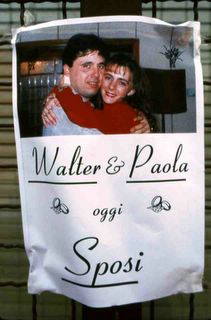
Well, not technically Italian, as Italy didn’t exist in the third century, when the priest, Valentine, stood on the side of love and free will and married young couples in defiance of Roman emperor Claudius II’s decree that young men could not wed. The emperor had decided that unattached men made better soldiers than their married counterparts. Valentine, a make-love-not-war type, performed marriages anyway and paid with his life.
It fits that a man whose life legend gave rise to a holiday celebrating love came from what is now Italy, a land to which I could return and return endlessly. Italy is beauty and romance and sun and light and breeze and blue water and sweet nothings and rich tastings and languid afternoons and shimmering evenings. Italy isn’t a country. It’s a state of mind, a sensual experience to be savored.
Love was in the air when we visited Burano, a small island in the lagoon that surrounds Venice and environs. Crazy-colorful like a box of crayons, Burano’s houses are brilliant shades of purple, blue, red, orange, yellow, green. Vivid, gorgeous, great fun. I can’t imagine being depressed in Burano. There’s too much fantastic, spirited color.
As we walked the island’s main street, wide, cobbled and built aside the canal that flows through town, I saw a homemade flyer taped to the window of a small shop. Two young faces – the kind Valentine must have looked on – smiled from the poster, which announced: “Walter & Paola oggi Sposi” – “Walter and Paola married today.” Cheek to cheek, Walter and Paola shared their love with all of Burano. I hoped they’d put the poster up that morning, which would make “oggi” mean “today” actually, and not just in translation. Maybe we’d see a wedding.
We made our way to the broad, cobbled piazza that held Burano’s ancient church. We looked up at the church’s campanile, which tilted some 15 degrees. We’d seen the askew bell tower from the water on our approach to the island, and now we stood under it, trusting it wouldn’t topple onto our heads.
The piazza began to fill up with people dressed in their Sunday best. It wasn’t Sunday. Hot dog. We were going to see Paola marry Walter. We did our best to blend in with the wedding guests, but our backpacks looked like rhinoceroses in the sea of graceful, lace umbrellas the ladies carried to shield their faces from the sun. Burano lace is prized, and each of these exquisite, handmade umbrellas – some white, some a velvety black – was a work of art. I stood behind some of the ladies and examined the intricate, dreamy lace patterns as the sun played on the umbrellas.
Just before noon, Paola walked up Burano’s ancient main street on her father’s arm. He beamed. The train of Paola’s snow-white wedding dress brushed over the centuries-old pavement as she made her way to the church door. Her father lifted her veil, kissed her, and the wedding party and guests entered the church.
We didn’t want the rhinoceroses on our backs to spoil Paola’s wedding or wedding pictures, so we watched the nuptials from the window. Wagner’s Wedding March thundered from the church organ, filling Burano’s afternoon air. The crayon houses seemed to break into smiles. Paola glided up the aisle and joined Walter at the altar. Oggi sposi. Married today. St. Valentine would have loved it.
(In researching links for this post, I came across this webpage by someone named Annie. The page hasn’t been updated since 2002, but Annie shares some interesting Valentine’s Day legends, lore and holiday traditions around the world. Scroll down past the candy and cards stuff...)
Where shall we go next?
